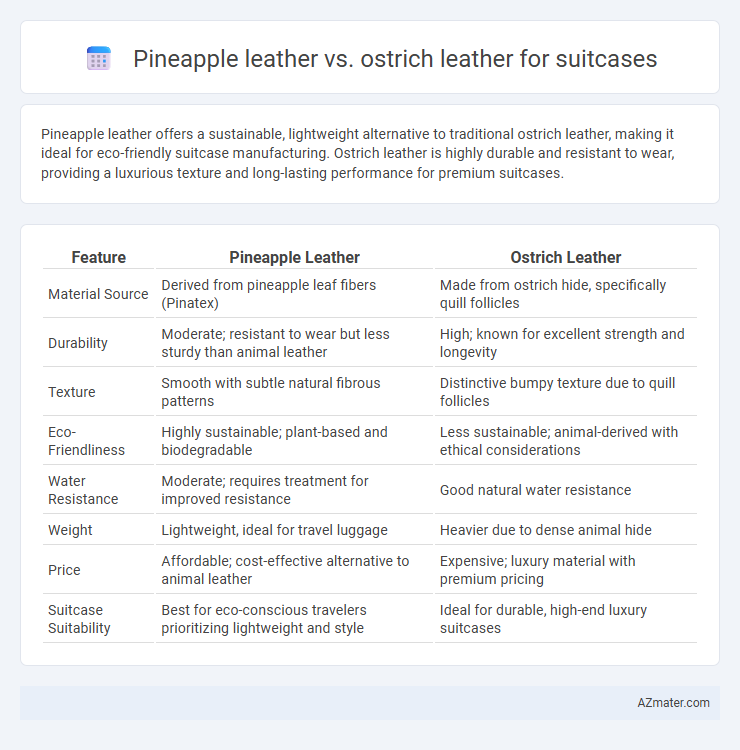Pineapple leather offers a sustainable, lightweight alternative to traditional ostrich leather, making it ideal for eco-friendly suitcase manufacturing. Ostrich leather is highly durable and resistant to wear, providing a luxurious texture and long-lasting performance for premium suitcases.
Table of Comparison
| Feature | Pineapple Leather | Ostrich Leather |
|---|---|---|
| Material Source | Derived from pineapple leaf fibers (Pinatex) | Made from ostrich hide, specifically quill follicles |
| Durability | Moderate; resistant to wear but less sturdy than animal leather | High; known for excellent strength and longevity |
| Texture | Smooth with subtle natural fibrous patterns | Distinctive bumpy texture due to quill follicles |
| Eco-Friendliness | Highly sustainable; plant-based and biodegradable | Less sustainable; animal-derived with ethical considerations |
| Water Resistance | Moderate; requires treatment for improved resistance | Good natural water resistance |
| Weight | Lightweight, ideal for travel luggage | Heavier due to dense animal hide |
| Price | Affordable; cost-effective alternative to animal leather | Expensive; luxury material with premium pricing |
| Suitcase Suitability | Best for eco-conscious travelers prioritizing lightweight and style | Ideal for durable, high-end luxury suitcases |
Introduction to Pineapple Leather and Ostrich Leather
Pineapple leather, also known as Pinatex, is an innovative, sustainable material made from pineapple leaf fibers, offering a lightweight, eco-friendly alternative to traditional animal leathers. Ostrich leather, prized for its distinctive quill follicle patterns, provides exceptional durability, softness, and a luxurious texture favored in high-end luggage craftsmanship. Both materials deliver unique aesthetics and performance, with pineapple leather emphasizing sustainability and ostrich leather highlighting premium quality and longevity for suitcase construction.
Source Materials: Sustainability and Ethics
Pineapple leather, derived from the leaves of pineapple plants, offers a sustainable alternative by utilizing agricultural waste, reducing environmental impact through zero deforestation and minimal water usage. Ostrich leather, sourced from farm-raised ostriches, involves ethical considerations related to animal welfare and resource-intensive farming practices, including high water and feed consumption. Choosing pineapple leather supports cruelty-free production and promotes a circular economy, whereas ostrich leather often appeals to luxury markets despite its higher ecological footprint.
Appearance and Texture Comparison
Pineapple leather exhibits a smooth, slightly fibrous texture with a matte finish, offering a modern, eco-friendly aesthetic that contrasts sharply with ostrich leather's distinctive quill follicle pattern and natural glossiness. Ostrich leather boasts a luxurious, supple feel with unique bumps providing both visual interest and tactile richness, while pineapple leather's uniform texture presents a minimalist yet durable surface. The vibrant grain and high sheen of ostrich leather make it ideal for high-end suitcases, whereas pineapple leather suits consumers seeking sustainable, vegan alternatives with a contemporary look.
Durability and Longevity
Pineapple leather, a sustainable alternative made from pineapple leaf fibers, offers moderate durability but is less resistant to abrasion and water compared to ostrich leather. Ostrich leather is renowned for its exceptional toughness, flexibility, and natural resistance to wear, making it ideal for suitcases that endure frequent travel and rough handling. Its unique quill pattern also contributes to longevity, maintaining structural integrity and aesthetic appeal over years of use.
Weight and Suitcase Practicality
Pineapple leather, made from Pinatex fibers, is notably lightweight compared to traditional ostrich leather, reducing overall suitcase weight and enhancing travel convenience. Ostrich leather, while heavier, offers exceptional durability and a unique, luxurious texture that withstands wear and tear from frequent handling. For practical suitcase use, pineapple leather excels in weight reduction, whereas ostrich leather provides long-term resilience and premium aesthetics.
Water Resistance and Maintenance
Pineapple leather offers excellent water resistance due to its synthetic fibers and treated surface, making it highly durable against moisture and easy to clean with just a damp cloth. Ostrich leather, while luxurious and naturally porous, requires regular conditioning and careful maintenance to prevent water damage and staining, as it is more susceptible to absorbing liquids. For suitcase applications, pineapple leather provides a low-maintenance, water-resistant option, whereas ostrich leather demands greater upkeep to maintain its appearance and integrity under wet conditions.
Environmental Impact Analysis
Pineapple leather, derived from biodegradable fibers of pineapple leaves, offers a significantly lower carbon footprint and reduced water usage compared to ostrich leather, which involves resource-intensive animal farming with notable methane emissions. The production of pineapple leather eliminates the ethical concerns and environmental degradation linked to ostrich farming, such as habitat disruption and chemical tanning pollution. Consequently, pineapple leather stands out as a sustainable alternative for suitcase manufacturing, promoting circular economy principles and minimizing ecological harm.
Cost Differences and Value for Money
Pineapple leather, also known as Pinatex, is generally more affordable than ostrich leather, making it a cost-effective option for suitcases while offering sustainable and cruelty-free benefits. Ostrich leather commands a premium price due to its durability, distinctive quill pattern, and luxurious appeal, often providing greater longevity and exclusivity. Value for money depends on buyer priorities; pineapple leather suits eco-conscious consumers seeking trendy design at lower cost, whereas ostrich leather appeals to those willing to invest in high-end, long-lasting craftsmanship.
Consumer Trends and Brand Adoption
Pineapple leather is gaining traction among eco-conscious consumers seeking sustainable alternatives to traditional materials, driving increased adoption by forward-thinking suitcase brands emphasizing ethical production. Ostrich leather remains favored for its distinctive texture and durability, appealing to luxury markets prioritizing exclusivity and premium craftsmanship. Emerging consumer demand for transparency and environmental responsibility is accelerating the integration of pineapple leather in suitcase collections, reflecting a broader shift toward plant-based materials in fashion accessories.
Conclusion: Which Leather Suits Your Style and Needs
Pineapple leather offers a sustainable, cruelty-free alternative with a lightweight and textured finish ideal for eco-conscious travelers seeking modern style. Ostrich leather delivers unmatched durability and a unique, luxurious pattern suited for those prioritizing classic elegance and long-lasting wear. Choosing between pineapple and ostrich leather depends on whether you value environmental responsibility and contemporary aesthetics or premium toughness and timeless sophistication in your suitcase.

Infographic: Pineapple leather vs Ostrich leather for Suitcase
 azmater.com
azmater.com